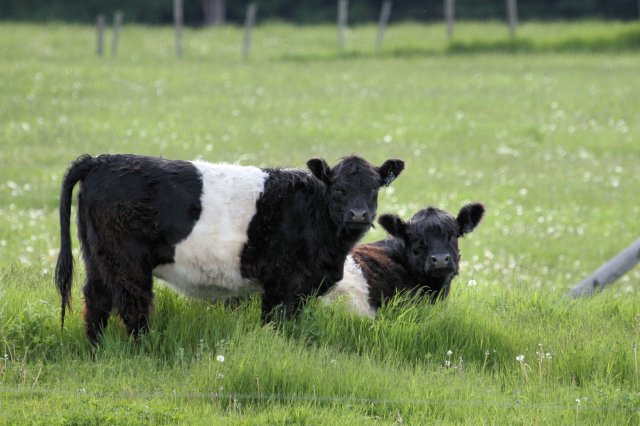
Cattle and sheep are blamed for contributing to greenhouse gases, belching out methane, and farmers in the future are likely to be taxed because of it.
The recent Green Left Weekly climate change liftout [issue #1078] calls for a drastic reduction in sheep and cattle numbers. There is a TV advertisement, urging people to “go vego to save the planet”. This is a gross misunderstanding of the ruminant carbon cycle.
Ruminants have always emitted methane; it is not something new. Huge herds of wild buffalo, cattle, goats, sheep, deer, cameloids and wildebeest have grazed the grasslands of the world for millions of years. The American prairies once supported greater numbers of bison than they now do cattle, despite the intensive corn and soy production that feeds them.
Methane emissions from wild ruminants was never a problem because nature does not permit waste — the methane was used as food for methanotrophic bacteria in the soil and neutralised. It was never a problem until agricultural practices started destroying these methanotrophic bacteria, which are very sensitive to chemical fertilisers and herbicides. These bacteria reactivate in biologically managed soil.
However, methane is not the whole picture. When the contribution of livestock to soil carbon sequestration is taken into account it is easy to see that ruminants do not increase greenhouse gases if they are managed well.
Grassland soils are the greatest sequesters of carbon — greater than forests. In the top one metre of soils in temperate grasslands there is an average of 236 tonnes of carbon, compared to 96 in temperate forest soils and 80 in cropland.
Grasslands need animals to stay healthy. Grasslands, when they are well managed with rotational grazing and adequate recovery time — as they are by wild herds and by shepherds, cowherds and goatherds and a rising number of graziers — pump carbon into the soil. Poorly managed, set stocked and overgrazed pastures lose carbon. It is not the animals that do the damage, it is the way they are managed.
The roots of grasses pump up to 40% of the carbohydrates they manufacture into the soil to feed microbial populations, which, in turn, release locked up nutrients from the soil that the grasses can use.
The most important of these microbes are mycorrhizal fungi, which invade the plant roots and through their mycelium networks effectively enlarge the root foraging area of the grasses tenfold, enabling the grassland to survive droughts. A by-product of this process is the formation of humus, the stable form of soil carbon.
However, the mycorrhizae are decimated by nitrate and phosphate fertilisers, herbicides and fungicides and become inactive in non-biologically managed soil.
Research at Strathfieldsaye Estate, an organic beef producing farm in Gippsland, has shown that over a period of four years of planned grazing, soil carbon levels have risen by 20-30% in the topsoil and 200% in the subsoil. This system, which many farmers are taking up, is sequestering large amounts of atmospheric carbon.
Lot feeding of cattle is an entirely different matter. The production of corn, soy and grains to feed the cattle is destructive of soil carbon, because of the ploughing that destroys soil organic matter, the nitrate fertilisers that burn it up, and the land clearing, particularly in Latin America, that is done to plant these feed crops.
There is also a huge loss from nitrate fertilisers of nitrous oxide into the atmosphere. Nitrous oxide is 300 times more potent as a greenhouse gas than carbon dioxide.
Lot feeding is an irresponsible farming activity not only for carbon destruction reasons. It is highly inefficient and produces poor quality meat. It takes at least five kilograms of grain protein to produce one kilogram of meat protein, and 40% of the world's grain harvest is fed to livestock.
Cattle are not naturally grain eaters, and being forced to eat grain damages their internal organs and invites diseases that have to be treated with antibiotics to keep the animals alive.
Cattle, goats and sheep convert cellulose that we cannot digest to milk and meat that we can, and sheep produce wool. Well managed, they take carbon out of the atmosphere and place it in the soil. They make otherwise unproductive areas fertile.
Livestock are an essential part of any ecosystem — there is not a natural land ecosystem in the world that is devoid of animals. Under organic standards all farmers must have livestock as part of their productive system, and so they should, to process crop wastes and activate the soil.
We need more cattle and sheep in Australia, not fewer. Many cropping areas have dispensed totally with sheep and replaced the role of sheep in weed management with herbicides and nitrates, the great destroyers of soil carbon. For sustainable agriculture the animals have to be brought back.
There is absolutely no justification for grass-fed livestock producers to be penalised under carbon trading, or for environmental organisations to call for stock reductions.
[Alan Broughton is a biological agriculture researcher and teacher at Strathfieldsaye Estate.]
Like the article? Subscribe to Green Left now! You can also like us on Facebook and follow us on Twitter.